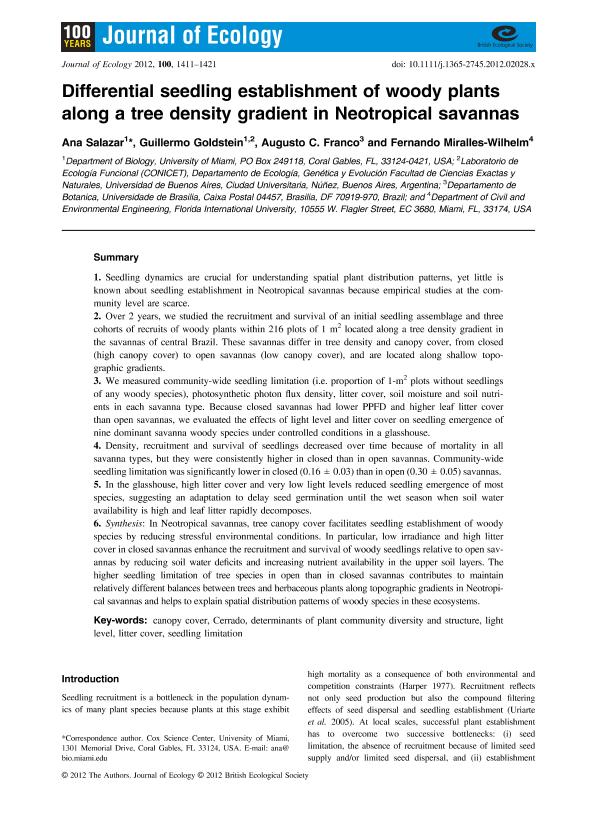Mostrar el registro sencillo del ítem
dc.contributor.author
Salazar, Ana
dc.contributor.author
Goldstein, Guillermo Hernan

dc.contributor.author
Franco, Augusto C.
dc.contributor.author
Miralles Wilhelm, Fernando
dc.date.available
2019-01-17T19:19:25Z
dc.date.issued
2012-11
dc.identifier.citation
Salazar, Ana; Goldstein, Guillermo Hernan; Franco, Augusto C.; Miralles Wilhelm, Fernando; Differential seedling establishment of woody plants along a tree density gradient in Neotropical savannas; Wiley Blackwell Publishing, Inc; Journal of Ecology; 100; 6; 11-2012; 1411-1421
dc.identifier.issn
0022-0477
dc.identifier.uri
http://hdl.handle.net/11336/68208
dc.description.abstract
Seedling dynamics are crucial for understanding spatial plant distribution patterns, yet little is known about seedling establishment in Neotropical savannas because empirical studies at the community level are scarce. Over 2 years, we studied the recruitment and survival of an initial seedling assemblage and three cohorts of recruits of woody plants within 216 plots of 1 m 2 located along a tree density gradient in the savannas of central Brazil. These savannas differ in tree density and canopy cover, from closed (high canopy cover) to open savannas (low canopy cover), and are located along shallow topographic gradients. We measured community-wide seedling limitation (i.e. proportion of 1-m 2 plots without seedlings of any woody species), photosynthetic photon flux density, litter cover, soil moisture and soil nutrients in each savanna type. Because closed savannas had lower PPFD and higher leaf litter cover than open savannas, we evaluated the effects of light level and litter cover on seedling emergence of nine dominant savanna woody species under controlled conditions in a glasshouse. Density, recruitment and survival of seedlings decreased over time because of mortality in all savanna types, but they were consistently higher in closed than in open savannas. Community-wide seedling limitation was significantly lower in closed (0.16 ± 0.03) than in open (0.30 ± 0.05) savannas. In the glasshouse, high litter cover and very low light levels reduced seedling emergence of most species, suggesting an adaptation to delay seed germination until the wet season when soil water availability is high and leaf litter rapidly decomposes. Synthesis: In Neotropical savannas, tree canopy cover facilitates seedling establishment of woody species by reducing stressful environmental conditions. In particular, low irradiance and high litter cover in closed savannas enhance the recruitment and survival of woody seedlings relative to open savannas by reducing soil water deficits and increasing nutrient availability in the upper soil layers. The higher seedling limitation of tree species in open than in closed savannas contributes to maintain relatively different balances between trees and herbaceous plants along topographic gradients in Neotropical savannas and helps to explain spatial distribution patterns of woody species in these ecosystems.
dc.format
application/pdf
dc.language.iso
eng
dc.publisher
Wiley Blackwell Publishing, Inc

dc.rights
info:eu-repo/semantics/openAccess
dc.rights.uri
https://creativecommons.org/licenses/by-nc-sa/2.5/ar/
dc.subject
Canopy Cover
dc.subject
Cerrado
dc.subject
Determinants of Plant Community Diversity And Structure
dc.subject
Light Level
dc.subject
Litter Cover
dc.subject
Seedling Limitation
dc.subject.classification
Otras Ciencias Biológicas

dc.subject.classification
Ciencias Biológicas

dc.subject.classification
CIENCIAS NATURALES Y EXACTAS

dc.title
Differential seedling establishment of woody plants along a tree density gradient in Neotropical savannas
dc.type
info:eu-repo/semantics/article
dc.type
info:ar-repo/semantics/artículo
dc.type
info:eu-repo/semantics/publishedVersion
dc.date.updated
2019-01-16T18:12:34Z
dc.journal.volume
100
dc.journal.number
6
dc.journal.pagination
1411-1421
dc.journal.pais
Reino Unido

dc.journal.ciudad
Londres
dc.description.fil
Fil: Salazar, Ana. University of Miami; Estados Unidos
dc.description.fil
Fil: Goldstein, Guillermo Hernan. Consejo Nacional de Investigaciones Científicas y Técnicas. Oficina de Coordinación Administrativa Ciudad Universitaria. Instituto de Ecología, Genética y Evolución de Buenos Aires. Universidad de Buenos Aires. Facultad de Ciencias Exactas y Naturales. Instituto de Ecología, Genética y Evolución de Buenos Aires; Argentina. Universidad de Buenos Aires. Facultad de Ciencias Exactas y Naturales. Departamento de Ecología, Genética y Evolución; Argentina
dc.description.fil
Fil: Franco, Augusto C.. Universidade do Brasília; Brasil
dc.description.fil
Fil: Miralles Wilhelm, Fernando. Florida International University; Estados Unidos
dc.journal.title
Journal of Ecology

dc.relation.alternativeid
info:eu-repo/semantics/altIdentifier/doi/http://dx.doi.org/10.1111/j.1365-2745.2012.02028.x
dc.relation.alternativeid
info:eu-repo/semantics/altIdentifier/url/https://besjournals.onlinelibrary.wiley.com/doi/full/10.1111/j.1365-2745.2012.02028.x
Archivos asociados
